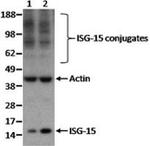Search Thermo Fisher Scientific
Invitrogen
ISG15 Monoclonal Antibody (3C2), eBioscience™
FIGURE: 1 / 2
ISG15 Antibody (14-5857-82) in WB


Product Details
14-5857-82
Species Reactivity
Published species
Host/Isotype
Class
Type
Clone
Conjugate
Form
Concentration
Purification
Storage buffer
Contains
Storage conditions
Shipping conditions
RRID
Product Specific Information
Description: This 3C2 monoclonal antibody reacts with mouse interferon stimulated gene-15 (ISG-15), a 15kDa ubiquitin-like protein (UBL) and cytokine. ISG-15 is translated as a precursor that is subsequently activated by an E1 enzyme, conjugated by an E2 enzyme via the C-terminal LRLRGG motif and ligated by an E3 ligase. The activity of ISG-15 is dependent on its modification of target proteins at specific lysine residues. Several viruses utilize ISG-15 and ubiquitin deconjugating proteases, while influenza B protein NS1 has been shown to specifically bind ISG-15 thereby blocking its conjugation.
In addition to its role as a protein modification, ISG-15 is secreted by monocytes and lymphocytes in response to IFNalpha, beta, or gamma, as well as influenza B virus. In this role as cytokine, it has been shown to induce secretion of IFNgamma and support NK cell proliferation and cytolytic activity.
Applications Reported: This 3C2 antibody has been reported for use in immunoblotting (WB).
Applications Tested: This 3C2 antibody has been tested by immunoblot of Raw 264.7 cell lysates at 2 µg/mL. It is recommended that the antibody be carefully titrated for optimal performance in the assay of interest.
Purity: Greater than 90%, as determined by SDS-PAGE.
Aggregation: Less than 10%, as determined by HPLC.
Filtration: 0.2 µm post-manufacturing filtered.
Target Information
Ubiquitin-like protein ISG15 plays a key role in the innate immune response to viral infection either via its conjugation to a target protein (ISGylation) or via its action as a free or unconjugated protein. It is secreted from monocytes in response to type I interferons and causes natural killer (NK)-cell proliferation and an augmentation of non-MCH (major histocompatibility complex)-restricted cytotoxicity. Synthesis is stimulated by IFN-alpha or IFN-beta or IFN-omega, but not IFN-gamma. ISG15 expression is also induced by overexpression of interferon regulatory factors that participate in transcriptional regulation of IFN genes, and by influenza B virus. ISG15 is secreted by cell lines of monocyte, T-lymphocyte, B-lymphocyte, human fibroblasts, and epithelial origins. Enhancement of NK cell proliferation, augmentation of non-major histocompatibility complex-restricted cytotoxicity, and induction of IFN-gamma from T cells identify ISG15 as a member of the cytokine cascade and suggest that it may be responsible for amplifying and directing some of the immunomodulatory effects of IFN-alpha or IFN-beta. ISG15 has has also been shown to function intracellularly as a ubiquitin homolog. Mutations affecting the gene can result in Immunodeficiency 38, with basal ganglia calcification (IMD38).
For Research Use Only. Not for use in diagnostic procedures. Not for resale without express authorization.
Bioinformatics
Protein Aliases: interferon, alpha-inducible protein; Interferon-induced 15 kDa protein; interferon-induced 15-KDa protein; Interferon-induced 17 kDa protein; interferon-stimulated protein (15 kDa); interferon-stimulated protein 15; IP17; Ubiquitin cross-reactive protein; Ubiquitin-like protein ISG15
Gene Aliases: G1p2; IGI15; IP17; Irfp; Isg15; UCRP
UniProt ID: (Mouse) Q64339
Entrez Gene ID: (Mouse) 100038882

Performance Guarantee
If an Invitrogen™ antibody doesn't perform as described on our website or datasheet,we'll replace the product at no cost to you, or provide you with a credit for a future purchase.*
Learn more
We're here to help
Get expert recommendations for common problems or connect directly with an on staff expert for technical assistance related to applications, equipment and general product use.
Contact tech support
